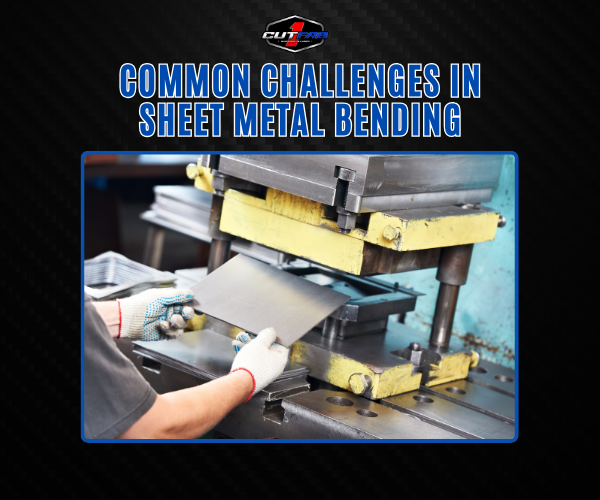
Common Challenges in Sheet Metal Bending—and How to Solve Them!
Sheet metal bending might seem straightforward, but even seasoned fabricators face unexpected hurdles. From material springback to inconsistent angles, the process is filled with nuances that can derail precision and efficiency. Understanding the common challenges in sheet metal bending is essential—not just for avoiding costly mistakes, but for improving productivity and part quality. Whether you’re working with stainless steel, aluminum, or copper, every bend presents unique risks. In this blog, we’ll break down the most frequent issues and provide practical solutions, so you can streamline your fabrication process and deliver consistent, high-quality results every time.
Top Challenges in Sheet Metal Bending (Springback, Cracking, Tooling Errors)
When it comes to sheet metal bending, three common challenges consistently trip up manufacturers: springback, cracking, and tooling errors.
Springback occurs when the metal tries to return to its original shape after bending, leading to imprecise angles. It’s especially common with high-strength materials and can ruin tight tolerances.
Cracking is another major issue, often caused by bending too sharply or using metal that lacks sufficient ductility. This can lead to weak points and eventual part failure—costing both time and money.
Tooling errors round out the list. Worn-out dies, mismatched punch sets, or incorrect tool setups can all lead to inconsistent bends and defective parts.
Recognizing these common challenges in sheet metal bending is the first step toward prevention. In the next section, we’ll explore how to solve each one with proven, real-world techniques that keep production efficient and parts flawless.
Material Behavior and Thickness: The Overlooked Factors
Understanding how different materials behave during bending is crucial to avoiding common challenges in sheet metal bending. Each metal—be it aluminum, stainless steel, or copper—reacts differently under pressure due to its unique mechanical properties. Factors like yield strength, ductility, and grain direction all play a role in how a material bends—and more importantly, how it resists deformation.
For example, aluminum is lightweight and easy to work with, but it’s more prone to cracking under sharp bends. Stainless steel, on the other hand, is much stronger but tends to exhibit more springback, requiring overbending or special tooling compensation.
Thickness is just as critical. Thinner materials are easier to bend but may wrinkle or warp if not handled properly. Thicker sheets demand more force and precise tooling to achieve accurate angles without inducing stress fractures or internal strain. A small miscalculation in bend allowance or radius can lead to significant dimensional errors, especially in high-precision applications.
Additionally, consistent material thickness is vital for automated bending systems. Even slight variations can throw off press brake settings and result in uneven parts. This is especially problematic in batch production where uniformity is key.
By carefully selecting materials based on application requirements—and adjusting bending parameters accordingly—you can significantly reduce errors and waste. Understanding material behavior and thickness isn’t just technical knowledge; it’s the foundation for efficient, high-quality metal fabrication.
Solutions and Prevention Strategies
Solving the common challenges in sheet metal bending starts with a proactive approach rooted in precision, planning, and the right equipment.
To combat springback, use compensation techniques such as overbending or bottoming. Choosing materials with predictable elastic properties and using CNC press brakes with angle sensors can greatly improve accuracy.
Preventing cracking requires a clear understanding of the material’s bend radius. Follow manufacturer guidelines on minimum bend radii and consider annealing metals before bending to increase ductility. Also, bend with the grain direction when possible to reduce fracture risk.
For tooling errors, regular maintenance is key. Inspect dies and punches frequently, and ensure proper alignment and compatibility with your press brake. Investing in high-quality, application-specific tooling can dramatically reduce scrap and rework.
In addition, use simulation software to preview bends and catch errors early. Implementing quality control checks—like trial bends and real-time monitoring—helps maintain consistency across batches.
Training your team is just as important. Operators who understand the material, equipment, and software are better equipped to adapt to variations and minimize mistakes.
With the right strategies in place, you can transform sheet metal bending from a pain point into a competitive advantage.
Designing for Better Bending
Smart design is one of the most effective ways to avoid the common challenges in sheet metal bending. It starts with understanding the limitations of your material and the capabilities of your equipment.
Always design with proper bend radii in mind—sharper bends may look cleaner on paper, but they increase the risk of cracking and deformation. Use generous radii and consistent bend lines to improve accuracy and reduce stress on the material.
Part orientation matters too. Bending with the grain of the metal can prevent fractures, especially in harder materials like stainless steel. Adding relief cuts or bend reliefs can eliminate tearing and distortion at corners.
Also, simplify geometry where possible. Fewer bends and symmetrical designs are easier to fabricate and more consistent in production.
By thinking about bend mechanics during the design phase, you’ll avoid costly revisions and ensure smoother fabrication from the very first prototype.
Conclusion
Mastering the art of sheet metal bending requires more than just the right tools—it demands a deep understanding of material behavior, design principles, and process control. By addressing the common challenges in sheet metal bending—like springback, cracking, and tooling errors—you can significantly improve accuracy, reduce waste, and boost production efficiency. With smart design, proper training, and preventive strategies, you’ll minimize costly mistakes and achieve consistently high-quality results. Whether you're scaling up production or fine-tuning prototypes, overcoming these bending challenges is key to long-term fabrication success.
